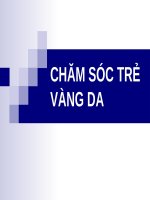Bài giảng chăm sóc trẻ viêm màng não
Bạn đang xem bản rút gọn của tài liệu. Xem và tải ngay bản đầy đủ của tài liệu tại đây (864.38 KB, 37 trang )
1
Pediatric Nursing Care Planning
for Bacterial Meningitis
Tran Thi Hong Van-MD,MS
2
Learning objectives:
1. Knowledge:
•
Presenting the definition, etiology, epidemiology
and pathology of meningitis.
•
Presenting signs, symptoms and complications
used to be assessed in nursing care the child
with meningitis.
•
Presenting nursing diagnoses of meningitis in
children.
•
Presenting nursing care planning for children
with meningitis.
3
Learning objectives:
2. Practice:
•
Assess some signs, symptoms and complications in
child with meningitis.
•
Identify nursing diagnosis for child with meningitis and
care planning.
•
Perform some skills in nursing care for children with
meningitis:
assistant doctors to do lumbar puncture
keeping patients in the right position
administer oxygen by face mask
suction the child, suction by equipment as needed
monitoring respiratory and cardiovascular status
4
Learning objectives:
3. Attitude
Having knowledge that:
•
Bacterial meningitis is very serious
disease; it can lead the patient to the dead
or sequalae for life.
•
The mistake in treatment and nursing
care cause the increase incidence of
mortality and sequalae.
5
1. Definition
•
Meningitis is inflammation of the meninges
of the brain, spinal cord, or both.
•
Causes: Bacteria, virus, fungi, parasites
Aseptic meningitis
•
Bacteria and viruses are the most often of
meningitis.
•
Bacterial meningitis = pyogenic meningitis
6
7
8
2. Etiology
1. Post-neonatal meningitis (after age 1 month)
•
Bacteria:
- Most cases are caused by:
Neisseria meningitidis (Meningococcus)
Hemophilus influenzae type b
Streptococcus pneumoniae (Pneumococcus)
+
Vaccination reduce these diseases
+
All 3 pathogens can be isolated from the throat or nasopharynx of
healthy individuals.
- Others : Streptococcus group B, Gr (-) enteric
bacilli, Listeria monocytogenes, Staphylococcus
aureus, Pseudomonas aeruginosa …
9
2. Etiology
2. Neonatal meningitis:
•
Group B β-hemolytic streptococci
(Streptococcus agalactiae)
•
Escherichia coli
(Streptococcus agalactiae & Escherichia coli account for
50–66% of cases of neonatal meningitis).
•
Listeria monocytogenes ( approximately 1–5%).
•
Klebsiella…
10
3.Epidemiology
•
Incidence
–
Neonatal meningitis occurs in 0.2–1 per 1000
live births.
–
Hib meningitis decreased from 40 cases per
100,000 children < 5 yrs to 1 case per
100,000 & lower due to vaccinate
•
Age
In the US
−
300–400 cases per 100,000 live births
−
141cases per 100,000 during the second
month of life
−
< 50 cases per 100,000 in the second year of
life
11
Image 049_23. Haemophilus influenzae Infections.
Incidence of H influenzae type b (Hib) and non-type b invasive disease, per 100,000
population, United States, 1989 to 1996. The marked decrease in incidence of type b
disease is the result of routin Hib vaccin administration
12
3.Epidemiology
•
Rick factors:
- Age: < 3
yrs
, specially in newborn.
-
Gender: male > female
-
Immunodeficiency: premature newborn, malnutrition,
chronic diseases, AIDS…
-
Acute or chronic infectious diseases in
respiratory and ENT.
-
Malformation or trauma in brain, spinal cord :
meningocele, ventricular drainage, craniocerebral
trauma, lumbar puncture
-
Crowded population and poor hygiene
13
4.Pathology and Pathophysiology
•
Meningeal purulent exudate: distributed around the cerebral
veins, venous sinuses, convexity of the brain, and cerebellum and in the
sulci, sylvian fissures, basal cisterns, and spinal cord
•
Ventriculitis with bacteria and inflammatory cells in ventricular fluid
(more often in neonates), may subdural effusions and, rarely, empyema
•
Perivascular inflammatory infiltrates
small arteries and veins, vasculitis, thrombosis of small cortical veins,
occlusion of major venous sinuses, necrotizing arteritis
producing subarachnoid hemorrhage, cerebral cortical necrosis
•
Cerebral infarction, resulting from vascular occlusion due to
inflammation, vasospasm, and thrombosis
•
Increased ICP due to inflammation, brain parenchymal edema, CSF
obstrution.
•
The syndrome of inappropriate antidiuretic hormone secretion (SIADH)
•
Hydrocephalus due to adhesive thickening of the arachnoid villi around
the cisterns at the base of the brain, interference with the normal
resorption of CSF; fibrosis and gliosis of the aqueduct of Sylvius or the
foramina of Magendie and Luschka.
•
Raised CSF protein levels ; Hypoglycorrhachia (reduced CSF glucose
levels)
14
Bacteria
Contiguous focus
of infection
Nasopharynx
Bacteremia
Meninges
Macrophase
TNF, prostaglandin
Brain parenchymal edema
CSF obstrution.
Increased ICP
Hydrocephalus
Cerebral infarction
Perivascular inflammatory
infiltrates
Clinical findings
1.3. Cơ chế bệnh sinh:
15
5. Signs and Symptoms
•
Fever
•
Irritability
•
Anorexia
•
Headache
•
Nausea
•
Vomiting
•
Confusion
•
Back pain
•
Nuchal rigidity
•
Photophobia
16
5. Signs and Symptoms
–
Kernig sign
•
Extend the leg at the knee of the supine patient while the
hip is flexed at 90 degrees.
•
When positive, the maneuver causes extensor spasm of
knee and pain in hamstrings when the lower leg is
extended to approximately 135 degrees.
–
Brudzinski sign
•
Flex the neck of the patient in the supine position.
•
When positive, the patient will involuntarily flex hips and
knee.
17
5. Signs and Symptoms
•
In a young infant, signs of meningeal
inflammation can be minimal or absent.
–
In patients < 12
mos
, absence of nuchal rigidity.
–
lethargy, poor feeding, restlessness.
–
Bulging fontanelle
•
Seizures
•
Petechiae and purpura, shock: meningococcal
disease.
18
•
Neonates
−
apnea
−
feed poorly
–
Hyperthermia or hypothermia
–
Irritability or lethargy
–
Respiratory distress or diarrhea (or both)
–
Nuchal rigidity (rarely)
–
Bulging fontanelle
19
6. Laboratory Findings
•
The initial laboratory examination should include:
–
CSF examination and culture
–
Blood culture
–
Measurement of serum electrolyte and glucose
concentrations
–
Complete blood count and platelet count
–
Measurement of urine specific gravity
•
If the patient has petechiae or purpura or is in shock,
then the laboratory tests should include:
–
Partial thromboplastin time
–
Prothrombin time
–
Measurement of fibrinogen- or fibrin-breakdown products
20
7.Treatment Approach
•
Acute bacterial meningitis is always a medical emergency;
should be observed closely .
•
Therapies that are crucial for all patients with bacterial
meningitis
–
Fluid management
–
Possible antiinflammatory adjunctive treatments
–
Antimicrobial therapy
•
As soon as bacterial meningitis is diagnosed, intravenous
administration of appropriate antimicrobial agents and possibly
antiinflammatory agents should begin.
•
Management of the child who is awake and has stable
cardiorespiratory vital signs consists primarily of:
–
Administering antimicrobial agents and fluids and careful monitoring
for:
•
Changes in level of consciousness
•
Development of seizures
•
Changes in vital signs
•
Development of the syndrome of inappropriate secretion of antidiuretic
hormone (SIADH)
21
7.Treatment Approach
•
Other therapies should be considered in more critically ill
children.
•
Seizures should be treated with appropriate
anticonvulsants.
–
An open airway that provides good oxygenation should be
ensured.
•
If increased intracranial pressure is a major clinical
concern and treatment has been initiated or is
anticipated, a neurosurgeon should be consulted and an
intracranial pressure monitoring device placed.
–
If an intraventricular catheter can be placed, then
increased intracranial pressure can often be treated by removing
CSF.
•
Placement of a pressure transducer affords continuous intracranial
monitoring, so that mannitol and hyperventilation can be used as
necessary to decrease pressure and maintain cerebral perfusion.
•
Decreased inflammation and increased cerebral perfusion probably
account for the benefits reported by some investigators with
dexamethasone therapy.
22
8. Prognosis
•
Encephalitis mortality
–
Despite the appropriate use of bactericidal antibiotics, the mortality rate for bacterial
meningitis remains 5–10%.
–
Case-fatality rate for neonates generally ranges from 20–25%.
–
In general, mortality is lower for full-term infants than for low–birth-weight infants (< 2500 g).
•
The case-fatality rate may approach 50% in low–birth-weight infants with gram-negative enteric
meningitis.
–
The case-fatality rate falls to approximately 5% for neonates who survive the first 24 hours.
–
Mortality of bacterial meningitis varies by pathogen.
•
21% for S pneumoniae
•
3% for N meningitidis
•
6% for Hib
•
Approximately 15–25% of survivors will have long-term morbidity, including:
–
Developmental delay
–
Seizure disorder
–
Spasticity
–
Hearing loss
•
Approximately 65% of survivors of coliform meningitis are normal 3–7 years after
illness.
–
Approximately 15–30% have mild to moderate neurologic sequelae.
–
5–10% have major sequelae.
•
Approximately 50% of group B β-hemolytic streptococcal meningitis survivors are
normal.
–
20% have mild to moderate sequelae.
–
15–30% have major sequelae, such as:
•
Hydrocephalus
•
Seizures
•
Profound intellectual disability
23
•
As many as 80% of neonates who have gram-negative enteric meningitis caused by
either Citrobacter or certain Enterobacter species will develop single or multiple brain abscesses.
–
Unusual in meningitis caused by any other organism
–
Routine follow-up with cranial CT is indicated for neonates with meningitis or sepsis caused
by Citrobacter species or Enterobacter sakazakii.
–
All infants recovering from meningitis should have careful audiologic testing and close evaluation for
attainment of developmental milestones.
•
Outcome of aseptic meningitis relates to both the causative agent and the child’s age.
–
Patients with enteroviral meningitis usually recover completely.
–
However, some studies have reported low intelligence and delayed speech development after enteroviral
meningitis in very young infants.
–
In light of these findings, the prognosis for an infant < 3 months of age is somewhat guarded.
–
The child’s development should be monitored carefully.
–
In general, when encephalitis accompanies aseptic meningitis, the clinical course is more severe and the
chance of sequelae increases.
•
Predicting long-term sequelae for an individual child is difficult at the time of hospital discharge.
–
Some children who are apparently normal are later found to have hearing or learning deficits or develop a
seizure disorder.
–
Conversely, some children expected to have a dismal prognosis based on abnormal neurologic
examinations make remarkable gains.
–
The practitioner should be guardedly optimistic with family while remaining sensitive to possible sequelae.
24
•
Hearing should be tested formally before discharge from the
hospital.
–
Most sensorineural hearing loss can be detected at this time.
–
The rate of persistent bilateral or unilateral sensorineural hearing loss
is:
•
31% after pneumococcal meningitis
•
10.5% after meningococcal meningitis
•
6% after Hib meningitis
–
In young infants, auditory brainstem response or otoacoustic emissions
testing is necessary for screening.
–
In older toddlers and children, conditioned response, play, or
conventional audiometry may be performed.
–
Current thinking asserts that much of the hearing loss in meningitis
occurs soon after infection.
•
This may explain why not all studies have shown reduction of hearing loss
by dexamethasone therapy.
•
Timing of other neurologic sequelae is less certain.
25
9. Nursing Diagnosis
2.1. Coma and convulsion related to increased intracranial
pressure (ICP):
-
increased intracranial pressure due to inflammation &
edema in brain, CSF obstruction
-
Coma and convulsion with different levels, may be no coma
and convulsion
2.2. Respiratory and CVS failure related to increased
intracranial pressure and/or infection
2.3. Hyperthermia related to infection and/or temperature
regulation centre
2.4. Electrolyse disorder related to SIADH, poor intake or
diarrhoea
2.5. Knowledge deficit related to home care









